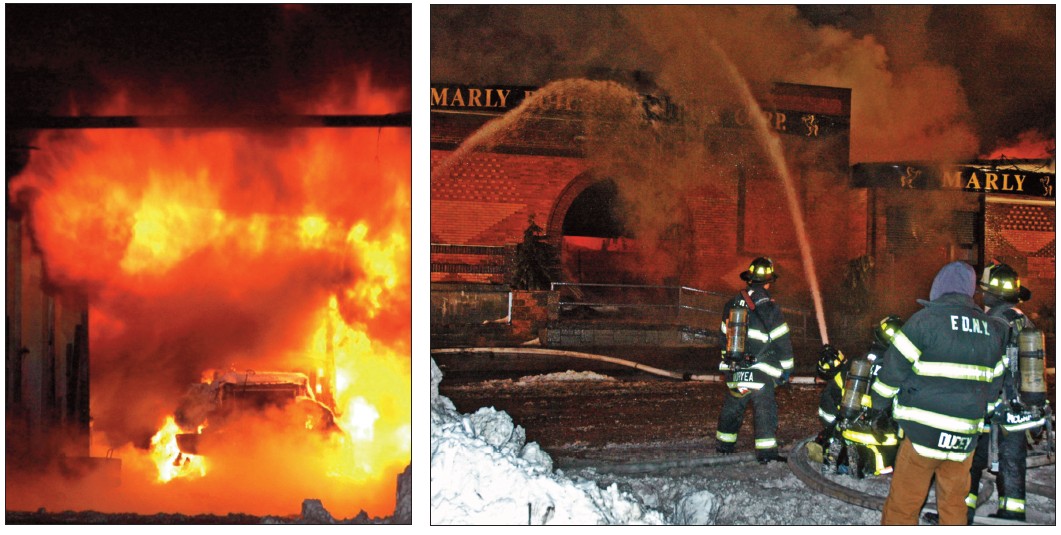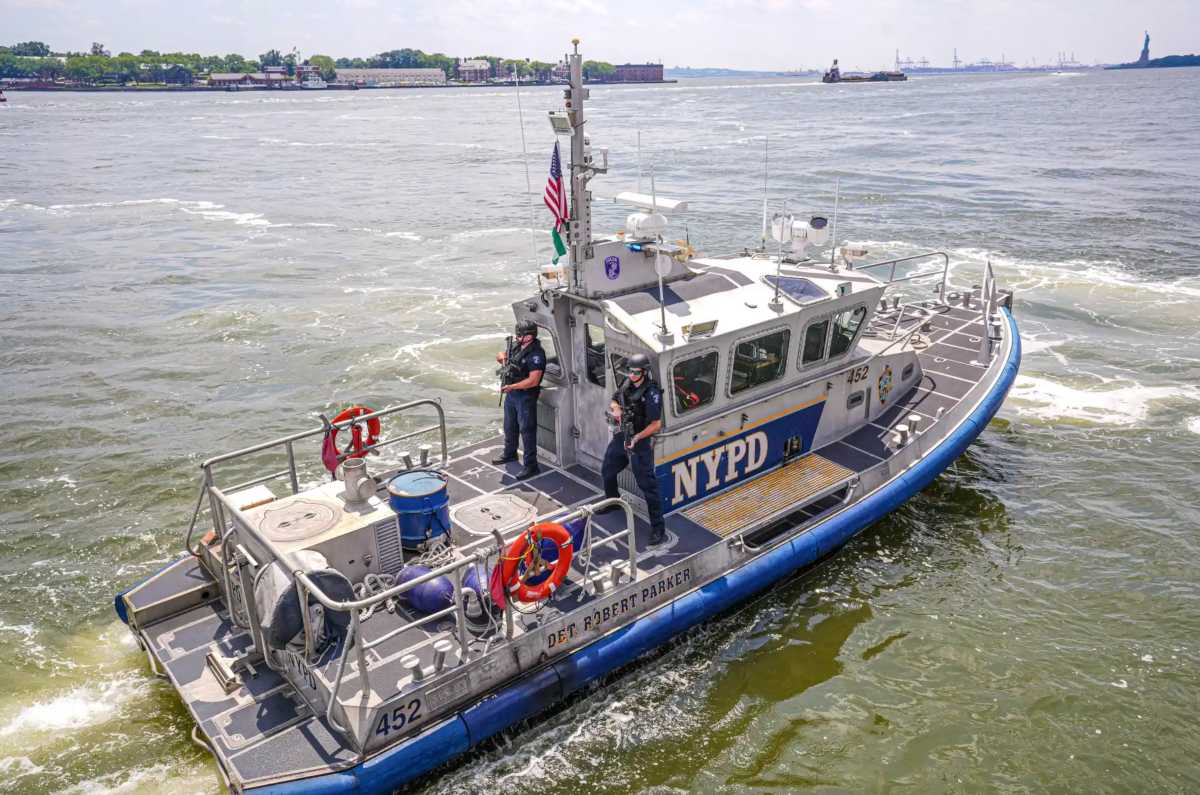Sunnyside Gets Look At New Kosciuszko
Sunnyside residents got a glimpse of the new Kosciuszko Bridge during a public meeting last Wednesday, July 16, that the state Department of Transportation (NYSDOT) held at Sunnyside Community Services.

Robert Adams, project director for NYSDOT and David Tullis, the design/build manager for contractors Skanska, Kiewit and Ecco III presented the plan to build the new spans over the Newtown Creek, estimated to cost a state-record $550 million.
Two new bridges will be constructed adjacent to the existing bridge, with work scheduled to be completed by 2018, according to NYSDOT.
The first bridge, which will eventually carry eastbound traffic, will be built on the existing bridge’s south side. Work will begin later this year, with the main pilings to support the new Queens-bound superstructure installed in 2015, Adams said.
“By the end of 2016, the first cable-stay span is largely complete, Adams said. “Traffic is then shifted onto the new bridge.”
The existing bridge will be demolished, and the new westbound Brooklyn span will be built in its place. That project will be bid in late 2017, NYSDOT public information officer Diane Park said.
The new bridges will reduce motorists delays by more than 65 percent at peak times, according to NYSDOT.
When complete, one bridge will solely carry traffic towards Brooklyn and the other into Queens, Adams said .
The new westbound bridge will carry four vehicle travel lanes, with one merger lane added that will end at the Meeker/Morgan avenues exit ramp, Park said. The Queens-bound bridge will carry five lanes of traffic, with two merging lanes that will end at the LIE exit, she stated.
On the Brooklyn-bound span a 20′ wide walking/bike path will be installed, officials said.
When completed, the new bridge will be the first strictly cable-stayed bridge in New York City.
Cable-stayed structures use steel cables connected at an angle to connect the roadway to the bridge towers that extend well above the traffic, Park said.
The need for the project is necessitated by several factors that slow down traffic and create delays on the current bridge, including steep inclines on the approach that force trucks to slow down to cross, Adams said .
The current bridge is 125 feet above the creek, Adams said. The new bridge will be approximately 40 feet lower than the existing span, it was noted.
“We’re still well high enough for any high ship to make it through the bridge and down Newtown Creek,” Adams said. “The problem with the existing bridge is trucks downshift when going over it.”
When the original bridge was designed, the creek was a very active waterway, according to Park. With demand for a fixed crossing, a bridge high enough to accommodate tall masted ships was built.
The Kosciuszko Bridge, named for a Polish general who served during the American Revolution, opened in 1939 and connected Meeker Avenue in Greenpoint with Van Dam Street in Long island City. It was later incorporated into the Brooklyn-Queens Expresssway’s (BQE) design, Park stated.
Incidents on the Kosciuszko can cause problems that effect a network of vital highways and arterial roads, creating backups along the BQE and snarling traffic in both Brooklyn and Queens.
“An incident that occurs on the Kosciuszko Bridge quickly spreads east to the LIE and west along the Williamsburg Bridge,” Adams said.
Over 160,000 vehicles cross the current span every day, he said.
The project will be completed in five phases.
The Queens-bound span will be completed first, “right parallel to the existing bridge,” Adams said.
Work on Phase 2, the new westbound bridge toward Brooklyn, will begin in early 2017, “at the same time Phase 1 is being completed,” Adams said.
Tullis updated residents on the timeline of the project. “Our first step is to make room by removing existing structures,” he said.
“All the buildings are acquired and vacated,” Adams noted.
The new bridges will provide improved sight distances for drivers, and optimize the street space below, Tullis said. They are “expected to last 100 years or more,” he added.
As manager of the design/build team, Tullis has seen the project develop and mature. He spoke on the cosmetic features of the bridge, as well as the gritty nuts and bolts of construction on such a massive scale.
“A lot of effort was put into choosing an aesthetic wing span,” Tullis said. The bridge “serves basically as a gateway between Brooklyn and Queens. We’re also balancing form and function … to get the most from both,” he said.
The design includes an architectural lighting design that can seen for miles at night, showing off the new bridge, he said.
“The soaring vertical towers will create a uniquely identifiable bridge, connecting the Brooklyn and Queens boroughs,” Park said in an email. “The edge girders, pilings and stays will be softly illuminated at night so the aesthetic benefits this project brings are not lost in the night sky, but rather subtly enhanced, providing an elegant addition.”
The demolition and removal of the existing bridge is also a large part of the project, Tullis stated.
The superstructure of the current bridge will be disassembled from the approaches and “will be lowered onto a barge in the creek and will go off for processing and recycling, Tullis said .
Adams spoke on the benefits of the project, including improved safety, reduced congestion, wider travel lane widths that conform to highway standards, improved shoulder widths, merge lanes in both directions and a reduced roadway incline.
“We certainly feel it will transform the New York skyline,” Adams said.
Additional funds from the project will finance renovations of nearby parks and streetscape improvements, including an expansion of Sgt. Dougherty Park in Brooklyn, Adams said.
New decorative lighting, street repairs, tree plantings and new sidewalks will also be installed in neighborhoods near the project, according to NYSDOT.
“This project is a design/build, so that is unique and has certain benefits,” Adams said. “It is roughly a 45 month-long process.”
He also stated that $70 million, allocated from Gov. Andrew Cuomo’s New York Works program, will be allocated toward disadvantaged bsuiness enterprises.
Responding to a question, Adams added, “streetscape improvements for Laurel Hill Boulevard, 56th Road and the streets between that,” will be included in the project. The LIRR tracks, the 43rd Street access ramp to BQE and streets beneath will remain in tact, he said.
The project is being funded by the Federal HighwayAdministration and allocations from the governor, officials said.
Skanska, a New York City-based contractor, will served as the managing partner for the project. HNTB Engineering was selected as the lead design firm, NYSDOT said.
The stakeholders advisory committee (SAC) will serve as a contact between the community and the project. The SAC is made up of aides to elected officials, agency represenatives, civic association members, community board members and residents, business representatives and transportation interests.
The NYSDOT has hired Christine Holowacz as a full-time community liaison to address any concerns. Her office will be located on the site, according to officials.






























